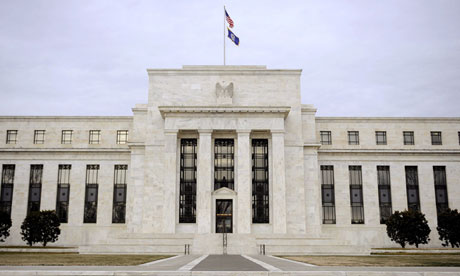 With the Fed meeting this week, attention is focused yet again on its statement, not its monetary tools. As many Fed followers correctly predicted, the Fed's arsenal of tools to combat weak growth and low inflation is waning, and has resulted on its increased reliance on the wording of its statements to influence and soothe markets. With rates at or near zero and the completion of its quantitative easing program (QE), the Fed has changed its approach to affecting markets focusing on communicating its intentions rather than implementing actual policies tools.
With the Fed meeting this week, attention is focused yet again on its statement, not its monetary tools. As many Fed followers correctly predicted, the Fed's arsenal of tools to combat weak growth and low inflation is waning, and has resulted on its increased reliance on the wording of its statements to influence and soothe markets. With rates at or near zero and the completion of its quantitative easing program (QE), the Fed has changed its approach to affecting markets focusing on communicating its intentions rather than implementing actual policies tools.March 18, 2015 - Fed Releases Statement and Removes "Patient"
 The Fed issued its statement on Wednesday and did not disappoint markets, as every market rallied as a result. Stock indices, energy, commodities, and bonds all rallied, some to record levels. What happened? Removing 'Patient' from its statement should have been bearish for markets, however, the Fed also lowered rate guidance in December, which helped soothe markets. Rallies like today's are often 'relief' rallies and can be short lived. As a result, the US 10-year treasury yield fell below 2.0%. Here is the Fed's March Dot Plot: Chart of FOMC participants of rate forecasts. The Fed cut its December rate forecast by 50 basis points. This alone has caused all markets to uniformly rally.
The Fed issued its statement on Wednesday and did not disappoint markets, as every market rallied as a result. Stock indices, energy, commodities, and bonds all rallied, some to record levels. What happened? Removing 'Patient' from its statement should have been bearish for markets, however, the Fed also lowered rate guidance in December, which helped soothe markets. Rallies like today's are often 'relief' rallies and can be short lived. As a result, the US 10-year treasury yield fell below 2.0%. Here is the Fed's March Dot Plot: Chart of FOMC participants of rate forecasts. The Fed cut its December rate forecast by 50 basis points. This alone has caused all markets to uniformly rally.How Long Do the Fed's Words Alone Soothe Markets?
For the time being, the Fed is getting the benefit of the doubt. Its words alone have soothed market expectations and kept equity markets buoyed. Most analysts agree, at least, that markets are 'fairly' valued if not overvalued. At what point do values hit the proverbial wall? Is the market's magic number the reciprocal of the 10-year US treasury, the equivalent metric from the fixed income market? If the risk-free rate of return is 2.0%, then the equivalent equity multiple should be 50, a far cry from the current 16.5 that the S&P 500 trades at. Why aren't we there yet? The historical average multiple is what is holding the market back. That multiple for the S&P 500 is around 15, leaving markets a little 'pricey'. Six years in to the current bull market without a significant 10% pullback is leaving investors and analysts a little hesitant to place bigger bets on the largest indices. The latest 'story' from money managers are that small cap stocks are the next growth area within the equities universe. With lofty current multiples and in the face of higher rates, that window may be short lived, as small caps fare worse than their larger cap brethren when liquidity starts to dry up. As multiples across the investment spectrum rise, the search for yield will only intensify. No one knows when or at what levels markets seize up, but the Fed's words will not infinitely soothe away the concerns the market is bound to have. At the moment the market tunes out Fed-speak, the market will crack and the long-awaited market correction will follow.



